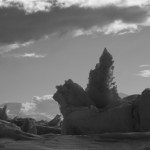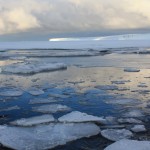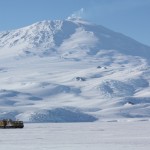Geography Transmissions
Jana Stefan – August, Ross Island, Antarctica
Jana Stefan discusses the how, where and when of her upcoming trip to Ross Island, Antarctica and what she anticipates to see when she gets there.
http://explore.royalbcmuseum.bc.ca/
An Ocean of Ice
Because the only way for the early explorers to approach the Antarctic continent was by ship, all of the historic sites that we work on are situated on the coast. And because the landscape surrounding these sites consists mostly of extremely rough and rocky volcanic cliffs, the easiest way to travel around Ross Island is on the sea ice. All of Antarctica is surrounded for most of the year by a wide belt of pack ice that forms, grows and shrinks depending on the season. When this ice is thick enough (usually in late winter, spring and early summer) we are able to walk, drive and even camp on it, but it takes a little bit of work to make sure that it is safe to do so. We have special drills and measuring tapes that we use to figure out if the ice is thick enough to travel on, and we are constantly monitoring the sometimes sizeable cracks that form in it to ensure that they are safe to cross. We establish routes that are known to be safe to travel on, and mark out designated ice ‘roads’.
Where the ice crashes into the shoreline, numerous tide cracks form, and we have to be especially careful when moving across these as they can change significantly throughout the course of even a single day, and a wrong step can result in an accidental swim! Because the sea ice is really just the ocean in frozen form, it too is affected by the tides and currents, and often gets pushed towards the shoreline in bays, coves and other restricted areas. In these areas, the pressure of the ice being pushed against the static shoreline forces it to crest up into fantastic formations called pressure ridges. The ridges get more and more pronounced as the ice gets pushed shorewards, and you can often hear the creaking and groaning of the ice getting forced upwards. We often go for walks between the ridges in the evenings when the sunlight is low and shining brilliantly off the ridges, and they are without a doubt one of my favourite things about living in Antarctica.
The warm summer weather causes the pressure ridges as well as the rest of the sea ice to weaken considerably, and all of the ice eventually breaks out leaving only open water where once there seemed to be solid ground. At that point we can travel only on the ‘hard’ (as the land around here is called), or by helicopter. The open water can sometimes last for months, but at times it may only be a couple of hours before new ice forms and the pack moves back in for the following year! It is never dull living in such close proximity to such a dynamic surface, and the sea ice never ceases to amaze me!
all photos and text: Jana Stefan 2013
- pressure ridges at cape armitage
- pressure ridge
- our old campsite is now underwater!
- new pancake ice forming even as old ice is still breaking out
- measuring sea ice thickness at a tide crack
- hagglunds travelling on ice road in front of mount erebus








